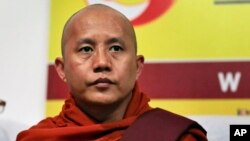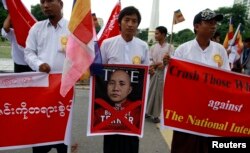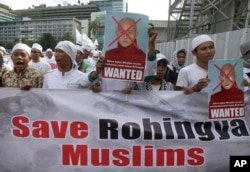Ashin Wirathu, the Burmese Buddhist monk known for whipping up anti-Muslim sentiment in Myanmar, is the subject of a new documentary airing at France’s renowned Cannes Film Festival, which starts Wednesday.
By filmmaker Barbet Schroeder, “The Venerable W” will appear in a special screening at one of the most prestigious cultural events in the world, marking the culmination of Wirathu’s journey from an obscure rabble-rouser to international infamy.
But his path to notoriety abroad points to questions back home about how much of a role the media have played in fueling his rise. Some believe he has been given too much of a platform for his hateful views or that coverage of his activities merits a more thoughtful approach.
Media attention for anti-Muslim views
“He has been famous because of the interviews and because of the posts in the local media,” said Thitsa Hla Htway, secretary of the Foreign Correspondents' Club of Myanmar.
He urged journalists to not report his more repugnant musings and to report on more diverse issues.
“What I want to stress is that they should just stay away from him and his popularity will go down. There are many important issues in Myanmar which are more important than him,” he said.
In and out of prison
This wasn’t the feeling five years ago, when Myanmar was emerging from military rule and grappling with ascendant Buddhist nationalist forces in the form of the 969 movement and Ma Ba Tha, the Committee to Protect Race and Religion.
Sentenced to prison for 25 years in 2003 for inciting violence, Wirathu was released in an amnesty in 2012, the same year that saw the first of several deadly riots to plague the country’s transition to democracy from nearly five decades of military rule.
'Time magazine' interview
Though Myanmar has long struggled to contain religious enmity, the story was not often heard outside of the country due to its isolation. That changed with a 2013 TIME magazine issue that put Wirathu on the cover and sought to explain the man's connection to the mayhem.
The initial coverage was revealing, but over the years, Wirathu was interviewed by countless journalists, including the author of this article. Doubt crept into the worthiness of the enterprise for many journalists.
Social media star
But his following on social media is enormous, his posts can be inflammatory, and the fact that he has not faced strong pushback implies he has connections.
Thiha Saw, the director of the Myanmar Journalism Institute, said he credits Wirathu’s rise more to the explosion of internet access that has occurred in recent years. He added that mainstream media outlets in Myanmar have been cautious about not giving Wirathu an unnecessary amount of exposure.
Supported military
But his level of influence remains an open question. He supported the military-backed ruling party in a 2015 election contest against Aung San Suu Kyi’s National League for Democracy, which won easily. This past March, Wirathu was hit with a ban on giving sermons for one year.
Even so, he was allowed to travel to a part of northern Rakhine State this month that has been largely closed off to observers since Rohingya militants attacked border posts in October, killing nine and setting off a crackdown that has resulted in accusations of possible crimes against humanity.
British journalist Oliver Slow, the chief of staff for the weekly magazine Frontier Myanmar, said in his personal opinion there needs to be a mix of scrutiny and restraint in the reporting.
Journalists want more scrutiny of Wirathu
“I think obviously he [Wirathu] needs to be heavily scrutinized. His group and the people behind him have the potential to cause massive issues, so I think it’s important to be reporting on him and what they are doing,” Slow said. “But I think we pretty much know all his views now, they’ve been aired for the past four or five years. His views on Muslims, his views on religion, have been so well aired, I just don’t really see any benefit any more of interviewing him.”
Matthew Smith, executive director of the NGO Fortify Rights, said in an email he isn’t persuaded by arguments the media has disproportionately fueled Wirathu’s rise to power, even if Wirathu has benefited from the attention.
“Wirathu is a populist demagogue with a considerable following and powerful connections behind the scenes,” Smith said. “But he and his followers have unarguably used international media attention to their advantage, to build their prominence and advance nationalist and racist narratives.”
Smith wants more investigative coverage of Wirathu.
“We see the occasional profile piece and don't find those terribly helpful. Most foreign readers, particularly in the West, regard Buddhism as a tranquil religion of peace, so editors have endless fodder in stories of an extremist monk who preaches hatred."
Schroeder, the filmmaker, did not immediately respond to a request for an interview sent through his production company.










